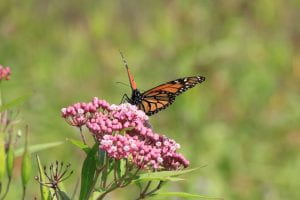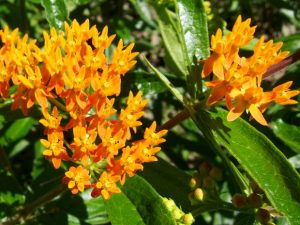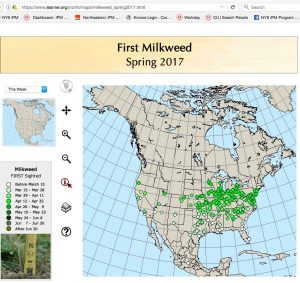Gorgeous in flight and gloriously colored, monarch butterflies are the glimmering icon of wild nature. As an endangered species, they’re also iconic of all we have to lose in a changing world.
And now it’s begun — the remaining monarchs’ first leg of an epic, multigenerational voyage from overwintering sites in Mexico. But are they too early?
Getting here takes food, and plenty of it. For monarchs streaming up the eastern flyway to summer in our gardens and wildlands, you want flowering plants that offer generous helpings of nectar, the butterfly equivalent of a protein shake with all the essential nutrients it needs. But you also need more: you need the one plant that protects monarchs from the animals that might eat them.

As for the nectar plants? All of us — farmers, gardeners, golf courses and park superintendents — can help, each in our own way, with plantings of nectar-rich plants that attract beneficial insects. And beneficial insects are one of the mainstays of good IPM.
But it’s milkweed alone with its protective toxins that the monarch butterfly lays its eggs on; that its caterpillars feed on. So of course, gardeners and golf-course or park superintendents will want to plant milkweed too. Many species are stately, short-lived perennials bearing fragrant flowers. (Farmers, you might — or not — have options for happily letting milkweed grow.)

Now … for that “too early?” part.
As we speak, monarchs seem to be moving north earlier than usual, supported by strong tailwinds. Yes, they’re finding some nectar sources — dandelions, for instance. (If you must mow now, mow high. Which you should do anyway if you practice good IPM.) But according to some reports (citizen scientists with Annenberg Learner’s Journey North and ecologist Chris Helzer’s Prairie Ecologist posts via The Nature Conservancy), monarchs seem to be looking for milkweed — and not finding it.

Or if the butterflies find milkweed, it tends to be just a few inches high. Question is: can a six-inch-tall milkweed support six to eight larvae? Unknown.
A close look at the map and you know they’re on their way.

Since scouting is another core tenet of IPM, be a good scout — and keep a sharp lookout for monarchs, milkweed, and monarch eggs. Three’s a charm!